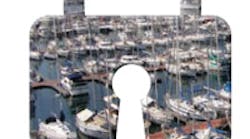This past June, US Seismic Systems (USSI) successfully completed a demonstration of its underwater harbor security system in Lake Erie, PA. The demonstration, which is part of a contract with Penn State's Electro-Optics Center, was sponsored by the Naval Surface Warfare Center (NSWC). For the purposes of this test, USSI installed two fiber-optic sonar arrays on the lake bottom.
The purpose of those arrays was to detect small craft attempting to enter a protected "region of interest." They were positioned to generate beamformed tripwires that met at the region of interest. Vessels crossing the tripwires or entering the region of interest generated an alarm. A command post was set up at a campground on shore. The system positively detected 100% of the intrusion attempts at ranges to 4 km.
With the success of this demonstration, the system showed that it is feasible to use a low-cost, fiber-optic, underwater sonar array to provide automated tripwire and region-of-interest alarms in a harbor environment (sans operator intervention).
The equipment used in the demonstrations was part of a larger integrated harbor security system from USSI, known as Harbor Sentinel. That system utilizes complementary sensor types. In addition to the acoustic arrays detecting propelled vehicles, radar, and automatic identification systems detect surface vessels, a 360-deg. panoramic camera with zoom capability identifies surface vessels. In addition, high-resolution, telescopic electro-optical/infrared (IR) cameras examine detected vessels. Data is passed from the sensors to a single operator station, where it is integrated into a comprehensive display. To learn more about the Harbor Sentinel system, visit http://eoc.psu.edu/expertise/imaging/ima_har_sen.html.

